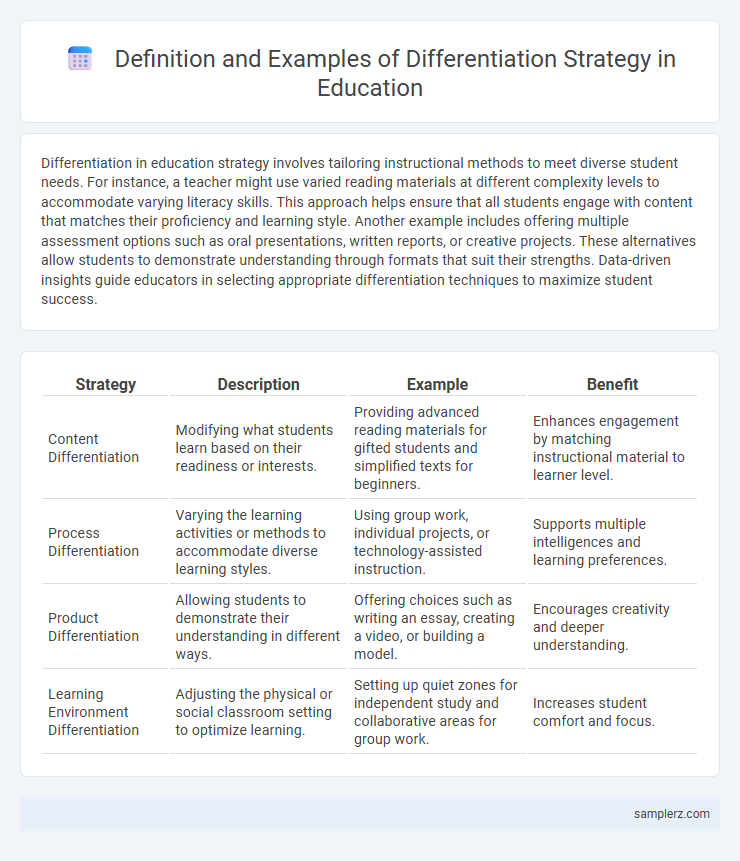Differentiation in education strategy involves tailoring instructional methods to meet diverse student needs. For instance, a teacher might use varied reading materials at different complexity levels to accommodate varying literacy skills. This approach helps ensure that all students engage with content that matches their proficiency and learning style. Another example includes offering multiple assessment options such as oral presentations, written reports, or creative projects. These alternatives allow students to demonstrate understanding through formats that suit their strengths. Data-driven insights guide educators in selecting appropriate differentiation techniques to maximize student success.
Table of Comparison
| Strategy | Description | Example | Benefit |
|---|---|---|---|
| Content Differentiation | Modifying what students learn based on their readiness or interests. | Providing advanced reading materials for gifted students and simplified texts for beginners. | Enhances engagement by matching instructional material to learner level. |
| Process Differentiation | Varying the learning activities or methods to accommodate diverse learning styles. | Using group work, individual projects, or technology-assisted instruction. | Supports multiple intelligences and learning preferences. |
| Product Differentiation | Allowing students to demonstrate their understanding in different ways. | Offering choices such as writing an essay, creating a video, or building a model. | Encourages creativity and deeper understanding. |
| Learning Environment Differentiation | Adjusting the physical or social classroom setting to optimize learning. | Setting up quiet zones for independent study and collaborative areas for group work. | Increases student comfort and focus. |
Understanding Differentiation in Educational Strategy
Understanding differentiation in educational strategy involves tailoring instruction to meet diverse student needs by varying content, process, and product based on learners' readiness, interests, and learning profiles. Effective differentiation employs flexible grouping, varied teaching methods, and ongoing assessment to ensure all students access curriculum at appropriate challenge levels. This approach enhances student engagement, promotes inclusive learning environments, and supports achievement across heterogeneous classrooms.
Differentiation by Content: Tailoring Learning Materials
Differentiation by content in education involves customizing learning materials to meet diverse student needs, such as offering texts at varying reading levels or incorporating multimedia resources for visual and auditory learners. This strategy enhances engagement and comprehension by aligning content complexity and delivery methods with individual student readiness and interests. Research shows that tailored content supports improved academic outcomes and fosters a more inclusive classroom environment.
Differentiation by Process: Varying Instructional Methods
Differentiation by process in education involves varying instructional methods to cater to diverse learning styles and needs, such as incorporating visual aids, hands-on activities, and technology-based tools. Teachers may design collaborative group work, individualized assignments, or tiered tasks to engage students effectively and promote deeper understanding. This strategic approach enhances student motivation and supports mastery by aligning teaching techniques with learners' unique cognitive preferences.
Differentiation by Product: Offering Diverse Assessment Options
Differentiation by product in education involves providing diverse assessment options such as project-based evaluations, oral presentations, traditional exams, and digital portfolios to accommodate multiple learning styles. This strategy enhances student engagement and allows educators to accurately measure competencies across varied skill sets. Incorporating flexible assessments supports personalized learning and improves academic outcomes by addressing individual strengths and challenges.
Differentiation Through Learning Environment
Differentiation through the learning environment involves tailoring classroom settings to accommodate diverse student needs, such as flexible seating arrangements, varied sensory inputs, and accessible technology integration. Providing quiet zones, collaborative spaces, and technology stations enhances engagement and supports different learning styles effectively. This strategy fosters inclusivity and maximizes student potential by addressing individual preferences and promoting active participation.
Technology Integration for Differentiated Instruction
Technology integration in differentiated instruction allows educators to customize learning experiences by using adaptive software that adjusts to individual student proficiency levels. Interactive platforms like Google Classroom and Kahoot enable real-time assessment and feedback, supporting personalized learning paths. Utilizing tools such as tablets and educational apps empowers students to engage with content at their own pace, enhancing comprehension and retention.
Grouping Strategies for Effective Differentiation
Grouping strategies for effective differentiation include flexible grouping, where students are organized based on skill levels or learning preferences to target specific needs. Homogeneous grouping allows tailored instruction that addresses similar abilities, while heterogeneous grouping fosters peer learning and diverse perspectives. These approaches optimize engagement and ensure instruction meets the varied readiness and interests within a classroom.
Differentiation for Gifted and Advanced Learners
Differentiation for gifted and advanced learners involves tailoring curriculum complexity and depth to challenge their higher cognitive abilities, such as offering accelerated content, independent projects, and enrichment activities. Educators implement strategies like compacting the curriculum and providing opportunities for critical thinking and creativity to foster intellectual growth. This approach ensures that gifted students remain engaged and develop skills in problem-solving, analysis, and innovation.
Differentiation for Students with Special Needs
Differentiation for students with special needs involves tailoring instructional methods, materials, and assessments to accommodate diverse learning abilities and challenges. Strategies include using multisensory approaches, individualized learning plans, and assistive technologies to enhance engagement and comprehension. Effective differentiation ensures that students receive equitable access to curriculum content, fostering academic growth and inclusivity.
Measuring the Impact of Differentiation in Education
Measuring the impact of differentiation in education involves analyzing student performance data, engagement levels, and personalized learning outcomes to assess effectiveness. Utilizing formative assessments and feedback loops allows educators to adjust teaching strategies based on individual student needs, enhancing academic achievement and motivation. Data-driven insights from differentiated instruction contribute to identifying best practices and improving educational equity across diverse learner populations.

example of differentiation in strategy Infographic
 samplerz.com
samplerz.com